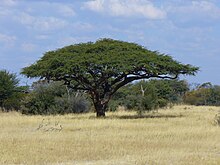Vachellia erioloba: Difference between revisions
==External links== * {{AfricanPlants|Acacia erioloba}} |
removed citation needed by supplying a trustworthy source |
||
| Line 30: | Line 30: | ||
The wood is a good fuel for fires, which leads to widespread clearing of dead trees and the felling of healthy trees. According to [[superstition]], [[lightning]] will strike at ''V. erioloba'' more readily than other trees.{{Citation needed|date=April 2013}} |
The wood is a good fuel for fires, which leads to widespread clearing of dead trees and the felling of healthy trees. According to [[superstition]], [[lightning]] will strike at ''V. erioloba'' more readily than other trees.{{Citation needed|date=April 2013}} |
||
The camel thorn's seeds can be roasted and used as a substitute for [[coffee bean]]s.{{ |
The camel thorn's seeds can be roasted and used as a substitute for [[coffee bean]]s.{{The seeds can be roasted and used as a substitute for coffee (http://www.plantzafrica.com/plantab/acaciaeriol.htm)|date=January 2012}} The Camel thorn is a protected tree in [[South Africa]].<ref name="dwaf"/> |
||
== Gallery == |
== Gallery == |
||
Revision as of 11:21, 11 November 2014
| Vachellia erioloba | |
|---|---|

| |
| Vachellia erioloba Camel Thorn | |

| |
| Seeds and pods | |
| Scientific classification | |
| Kingdom: | |
| (unranked): | |
| (unranked): | |
| (unranked): | |
| Order: | |
| Family: | |
| Genus: | |
| Species: | V. erioloba
|
| Binomial name | |
| Vachellia erioloba | |
| Synonyms | |
| |
Vachellia erioloba (Camel thorn, Giraffe thorn, Afrikaans: Kameeldoring, Tswana: Mogôtlhô, Sotho: Mogohlo)[2] is a southern African legume.[3] Its preferred habitat is the deep dry sandy soils of the Transvaal, western Free State, northern Cape Province, Botswana, and the western areas of Zimbabwe and Namibia. The tree was first described by Ernst Heinrich Friedrich Meyer & Johann Franz Drège in 1836.[4]
The tree can grow up to 17 metres high,And it is commonly found in Namibia. Its name refers to the fact that giraffe (kameelperd in Afrikaans) and camels commonly graze on the harder-to-reach succulent leaves normally out of reach of smaller animals. Giraffe in particular are partial to all vachellias and manifest a specially-adapted tongue and lips that can cope with the vicious thorns. It also grows ear-shaped pods, which are favoured by a large number of herbivores including cattle. The wood is dark reddish-brown in colour and extremely dense and strong. It is slow-growing, very hardy to drought and fairly frost-resistant.
The wood is a good fuel for fires, which leads to widespread clearing of dead trees and the felling of healthy trees. According to superstition, lightning will strike at V. erioloba more readily than other trees.[citation needed]
The camel thorn's seeds can be roasted and used as a substitute for coffee beans.Template:The seeds can be roasted and used as a substitute for coffee (http://www.plantzafrica.com/plantab/acaciaeriol.htm) The Camel thorn is a protected tree in South Africa.[2]
Gallery
-
The pods of the Camel thorn, while they remain on a tree (near Potgietersrust in Transvaal, South Africa)
-
Vachellia erioloba seeds, lying upon the ground, scattered among their pods, Sossusvlei, Namib Desert, Namibia
-
Mokala Bark on a tree near Potgietersrust in Transvaal, South Africa
-
The sharp thorns of the Mokala resemble barbed wire (growing near Potgietersrust in Transvaal, South Africa)
-
Vachellia erioloba tree in the Namib Desert
References
- ^ Kyalangalilwa B, Boatwright JS, Daru BH, Maurin O, van der Bank M. (2013). "Phylogenetic position and revised classification of Acacia s.l. (Fabaceae: Mimosoideae) in Africa, including new combinations in Vachellia and Senegalia". Bot J Linn Soc. 172 (4): 500–523. doi:10.1111/boj.12047.
{{cite journal}}: CS1 maint: multiple names: authors list (link) - ^ a b "Protected Trees" (PDF). Department of Water Affairs and Forestry, Republic of South Africa. 3 May 2013.
- ^ The type specimen of Acacia giraffae, proved on closer examination to be a hybrid of V. haematoxylon and the species which would later become known as V. erioloba. The name V. erioloba was therefore proposed for the vast numbers of Camel Thorn which are not hybrids.
- ^ USDA Germplasm Resources Information Network entry for Vachellia erioloba (as Acacia erioloba)
External links
- Dressler, S.; Schmidt, M. & Zizka, G. (2014). "Acacia erioloba". African plants – a Photo Guide. Frankfurt/Main: Forschungsinstitut Senckenberg.





